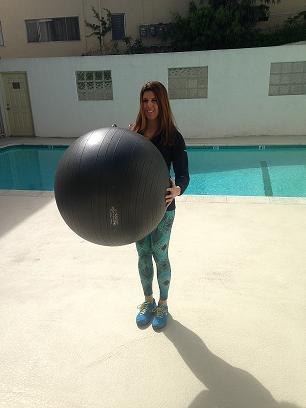The Anguish of Not Getting Results from Exercise
Do you want to shrink your body a size or two? Are you seriously interested in losing body fat and building muscle and having a sleek, lean body? If so, then you need a consistent, systematic exercise regime that actually delivers results. While any activity and just doing something is better for your health than doing nothing, the truth is that gardening, house cleaning and walking your dog won’t produce dramatic changes in weight or body shape.
My friend, Eleanor, for example, started a walking program because she wanted to take off weight and go from a size 12 to a size 8. After 3 months of walking 20 or 30 minutes three days a week, she hadn’t dropped a single pound. And her pants weren’t getting baggy, either! “It’s exasperating to put in this kind of time of effort and not see a difference,” complained Eleanor. This non-result was a source of genuine suffering and anguish for Eleanor. Of course, if she had measured it, Eleanor would have noticed a big difference in her cardiovascular health and fitness, and that’s a very big and important result. It’s just not the one she most wanted.
So when you’re just starting out on an exercise program it’s essential to differentiate between exercising for health and basic fitness and exercising for a dramatic change in weight or body shape. It’s much easier and it takes a lot less effort to exercise for basic health, and this is where everyone who’s not used to exercising should start out. On the other hand, it’s much harder and it takes a lot more effort to exercise to bring about a measurable change in weight or body shape. The only way to get a serious change in body composition, which is the relationship of your body fat to your muscles, is to inject a big dose of serious scientifically-based effort into your exercise regime.
In terms of exercise, effort is a combination of mode (what you’re doing), time (how long you do it), and intensity (how hard you do it.) The two modes that yield the biggest results are cardiovascular training for loss of body fat and strength training (also called resistance training) for increase in musculature. Both types of exercise are needed. And both need to be done in a way that cranks up the intensity level. You can't just shuffle through and expect to start shrinking! With cardiovascular training, intensity has to do with working out in your training zone, which is a range where you can get your heart to safely beat much harder than usual for an extended period of time. The formula for calculating your target zone is provided at the end of this article. With strength training intensity has to do with working your muscles to failure, which is the point where you can’t lift another weight.
Let’s go back to Eleanor for a moment and look at her program and try to understand why she didn’t get a result. For one thing, Eleanor only engaged in one mode or type of exercising: walking, which is a kind of cardiovascular training. In addition to her walking, Eleanor should also be doing strength training 2 or 3 days a week. But mode isn't the only problem with Eleanor’s exercise program. After the first three or four weeks of getting herself used to exercising, Eleanor should be walking much harder to make sure her heart rate beats faster and is in her target zone. This would require either picking up the pace or walking up hills or adding some light weights while walking. And there’s yet another refinment Eleanor could have done to improve her results: she could have walked more often. Eleanor’s total weight loss/body reshaping program should be done 6 days a week. Ideally, this would include 4 days of cardiovascular training and 2 days of strength training.
Let’s talk a little more about intensity. The good news is that the after-effects of exercising with intensity are heavenly. You get that big rush of happiness hormones. You get the big flush of every kind of tension. You get the big metabolic calorie burn. The bad news is that working with intensity is harder and less enjoyable. This is where two training tricks come in handy: interval training and alternating between periods of high intensity exercise and high volume exercise. Interval training is used with cardiovascular exercise. It’s the technique of introducing short, regular bursts of big energy into a lower energy workout. The short big intensity bursts of energy are called intervals. Here’s how it works. Instead of working really hard for a full 30 minutes, which is too difficult for most people, you can do ten one-minute high intensity intervals every third minute. Or you can do five two-minute high intensity intervals every third minute. Or any variation on the theme. Interval training is easier on cardiovascular equipment where the level or pace that you work at can be manipulated with a simple click of a button.
High intensity training (HIT) and high volume training (HVT) are techniques used in strength training to bring your muscles to failure, which is what you need to do create a sleek, lean, strong muscular body. The HIT technique causes muscle failure using very heavy weights with low repetitions. So, for example, the HIT protocol would involve lifting the heaviest weight you can safely manage for about 5 or 6 repetitions. The HVT technique causes muscle failure using light weights with lots of repetitions. With an HVT protocol, you lift light weights for 15 to 20 repetitions, take a brief rest and then repeat the entire 15 to 20 repetitions another one or two times or until the muscle tires. Both techniques work, but they don't work together. It’s best to alternate between an HIT and HVT routine every two or three months. An 8-week HIT training program could be followed by a 12-week HVT training program, which then reverts to another 8-week training program, and so on. This is a great way to stay out of an exercise rut and keep yourself interested, inspired and fresh.
While it's possible to use exercise to achieve a hard, sleek, strong body, it's useful to remember that a hard, sleek body is not necessary to be happy. Happiness comes from loving yourself enough to take care of yourself, and that is much easier to accomplish. Do you want to be healthy and have a basic level of fitness or do you want to really go for it? Before you start your exercise regime, take the time to figure it out because it will make a difference in what you do and how you do it.
Here’s how to calculate your target zone: Subtract your age from 220. 220 is the maximum heart beat of the average newborn baby. The reason for subtracting your age is because your heart beat decreases 1 beat for every year of life. So your maximum heart rate is 220-your age. Then go get your calculator and figure out 65% and 85% of your maximum heart rate. This is your target zone. You need to work at 65% to get a result. And for safety reasons you need to keep your heart rate at 85%. The very fit can increase the maximum to 90%.
-
Stress Eating: 5 Ways To Finally Beat It
Life is a challenge, plain and simple. Work, family, sc
-
Prevent Arthritis and Feel Younger for Longer
Have you ever noticed that your joints feel achy or stiff, espe
-
8 Ways To Drop Weight Now
In this world that we live in there are
-
How To Get Over A Weight Loss Plateau
Everyone who has ever tried to lose weight has hit a plateau at some p
-
Manage type 2 diabetes naturally with mindful eating habits
People around the globe find that food is a major focus, yet m
-
Scientists discover switch that turns on the thyroid
A recent survey shows that many people with thyroid disease ar
- DON'T MISS
- Why Are Electric Cars Becoming Popular Once Again?
- Heartworms In Dogs - What They Are & What To Do
- The easiest method to Acquire Six Pack Abs
- Weightlifting Workouts Help You Gain Weight
- Top Advice And Tips For Successful Weight Loss
- Prevent Arthritis and Feel Younger for Longer
- Looking for Fast Weight Loss? Think Again
- Burn Fat With Special Foods
- Weight Loss Is Never Easy
- Weight Loss Exercise To Lose Weight Naturally




